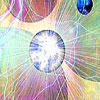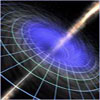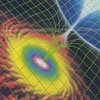Hyperdimensional Physics
 This is a annotated version of an original article by Richard C. Hoagland on the subject of “Hyperdimensional Physics.”
This is a annotated version of an original article by Richard C. Hoagland on the subject of “Hyperdimensional Physics.”
 Unknown to most current physicists and students of science (if not the general media and public), the beginnings of modern physics launched over 100 years ago by the so-called “giants” — Helmholtz, Lord Kelvin, Faraday, Maxwell and many others — laid a full and rich tradition in this currently little-known field: the open, heatedly debated scientific and philosophical premise that three-dimensional reality is only a subset of a series of higher, hyperspatial, additional dimensions, which control not only the physics of our very existence, from stars to galaxies to life itself … but potentially, through time-variable changes in its foundations–dramatic coming changes in our lives.
Unknown to most current physicists and students of science (if not the general media and public), the beginnings of modern physics launched over 100 years ago by the so-called “giants” — Helmholtz, Lord Kelvin, Faraday, Maxwell and many others — laid a full and rich tradition in this currently little-known field: the open, heatedly debated scientific and philosophical premise that three-dimensional reality is only a subset of a series of higher, hyperspatial, additional dimensions, which control not only the physics of our very existence, from stars to galaxies to life itself … but potentially, through time-variable changes in its foundations–dramatic coming changes in our lives.
This bold theoretical and experimental era, at the very dawn of science as we know it, came to an abrupt end at the close of the 19th Century. That was when our currently accepted (and very different) view of “physics” — everything from the “Big Bang” Expanding Universe Cosmology, to Relativistic limitations imposed by “flat” space and non-simultaneous time, complicated by a non-intuitive “Quantum Mechanics” of suddenly uncertain atomic “realities” — all took a very different turn … from where they had been headed.
The cornerstone of the hyperdimensional model (as applied to the problem of “unexplained” astrophysical energy sources) is that historically, there is a perfectly natural explanation for such “anomalous energy” appearing in celestial bodies … which, unfortunately, hasn’t been seriously considered by Science for over 100 years:
The existence of unseen hyperspatial realities … that, through information transfer between dimensions, are the literal “foundation substrate” maintaining the reality of everything in this dimension.
The mathematical and physical parameters required for such “information/energy gating” into this spatial dimension from potential “n-dimensions” were primarily founded in the pioneering work of several 19th Century founders of modern mathematics and physics: among these, German mathematician Georg Riemann; Scottish physicist Sir William Thompson (who would eventually be Knighted by the British Crown as “Baron Kelvin of Largs” for his scientific and technological contributions); Scottish physicist James Clerk Maxwell; and British mathematician Sir William Rowan Hamilton.
 In 1867 Thompson, following decades of inquiry into the fundamental properties of both matter and the space between, proposed a radical new explanation for the most fundamental properties of solid objects — the existence of “the vortex atom.” This was in direct contradiction to then prevailing 19th Century theories of matter, in which atoms were still viewed as infinitesimal “small, hard bodies [as] imagined by [the Roman poet] Lucretius, and endorsed by Newton …” Thompson’s “vortex atoms” were envisioned, instead, as tiny, self-sustaining “whirlpools” in the so-called “aether” — which Thompson and his 19th Century contemporaries increasingly believed extended throughout the Universe as an all-pervasive, incompressible fluid.
In 1867 Thompson, following decades of inquiry into the fundamental properties of both matter and the space between, proposed a radical new explanation for the most fundamental properties of solid objects — the existence of “the vortex atom.” This was in direct contradiction to then prevailing 19th Century theories of matter, in which atoms were still viewed as infinitesimal “small, hard bodies [as] imagined by [the Roman poet] Lucretius, and endorsed by Newton …” Thompson’s “vortex atoms” were envisioned, instead, as tiny, self-sustaining “whirlpools” in the so-called “aether” — which Thompson and his 19th Century contemporaries increasingly believed extended throughout the Universe as an all-pervasive, incompressible fluid.
 Even as Thompson published his revolutionary model for the atom, Maxwell, building on Thompson’s earlier explorations of the underlying properties of this “aetheric fluid,” was well on the way to devising a highly successful “mechanical” vortex model of the “incompressible aether” itself, in which Thompson’s vortex atom could live — a model derived in part from the laboratory-observed elastic and dynamical properties of solids. Ultimately, in 1873, he would succeed in uniting a couple hundred years of electrical and magnetic scientific observations into a comprehensive, overarching electromagnetic theory of light vibrations … carried across space by this “incompressible and highly stressed universal aetheric fluid …”
Even as Thompson published his revolutionary model for the atom, Maxwell, building on Thompson’s earlier explorations of the underlying properties of this “aetheric fluid,” was well on the way to devising a highly successful “mechanical” vortex model of the “incompressible aether” itself, in which Thompson’s vortex atom could live — a model derived in part from the laboratory-observed elastic and dynamical properties of solids. Ultimately, in 1873, he would succeed in uniting a couple hundred years of electrical and magnetic scientific observations into a comprehensive, overarching electromagnetic theory of light vibrations … carried across space by this “incompressible and highly stressed universal aetheric fluid …”
Maxwell’s mathematical basis for his triumphant unification of these two great mystery forces of 19th Century physics were “quaternions” — a term invented (adopted would be a more precise description) in the 1840s by mathematician Sir William Rowan Hamilton, for “an ordered pair of complex numbers” (quaternion = four). Complex numbers themselves, according to Hamilton’s clarifications of long-mysterious terms such as “imaginary” and “real” numbers utilized in earlier definitions, were nothing more than “pairs of real numbers which are added or multiplied according to certain formal rules.” In 1897, A.S. Hathaway formally extended Hamilton’s ideas regarding quaternions as “sets of four real numbers” to the idea of four spatial dimensions, in a paper entitled “Quaternions as numbers of four-dimensional space,” published in the Bulletin of the American Mathematical Society [4 (1887), 54-7].
It is obvious from Maxwell’s own writings that, even before Hathaway’s formalization, his choice of quaternions as mathematical operators for his electromagnetic theory was based on his belief that three-dimensional physical phenomena (including even perhaps the basis of human consciousness itself) are dependent upon higher dimensional realities. For, in honor of another great mathematician of the time, multi-dimensional geometer Arthur Cayley, Maxwell wrote …
“Oh WRETCHED race of men, to space confined!
What honour can ye pay to him, whose mind
To that which lies beyond hath penetrated?
The symbols he hath formed shall sound his praise,
And lead him on through unimagined ways
To conquests new, in worlds not yet created.
First, ye Determinants! In ordered row
And massive column ranged, before him go,
To form a phalanx for his safe protection.
Ye powers of the nth roots of – 1!
Around his head in ceaseless* cycles run,
As unembodied spirits of direction.
And you, ye undevelopable scrolls!
Above the host wave your emblazoned rolls,
Ruled for the record of his bright inventions.
Ye cubic surfaces! By threes and nines
Draw round his camp your seven-and-twenty lines-
The seal of Solomon in three dimensions.
March on, symbolic host! With step sublime,
Up to the flaming bounds of Space and Time!
There pause, until by Dickenson depicted,
In two dimensions, we the form may trace
Of him whose soul, too large for vulgar space,
In n dimensions flourished unrestricted.”— James Clerk Maxwell
To the Committee of the Cayley Portrait Fund — 1887
“My soul is an entangled knot,
Upon a liquid vortex wrought
By Intellect in the Unseen residing.
And thine doth like a convict sit,
With marlinspike untwisting it,
Only to find its knottiness abiding;
Since all the tool for its untying
In four-dimensional space are lying.”
 In another work (“The Aether,” 1876), Maxwell underscored the “ultimate” significance of these inquiries …
In another work (“The Aether,” 1876), Maxwell underscored the “ultimate” significance of these inquiries …
“Whether this vast homogeneous expanse of isotropic matter [the aether] is fitted not only to be a medium of physical Interaction between distant bodies, and to fulfill other physical functions of which, perhaps we have as yet no conception, but also as the authors of The Unseen Universe seem to suggest, to constitute the material organism of beings excercising functions of life and mind as high or higher than ours are at present, is a question far transcending the limits of physical speculation …”
See Part II
Posted in Science For The New Agewith comments disabled.






